Topic 8
1/152
Earn XP
Description and Tags
Name | Mastery | Learn | Test | Matching | Spaced |
|---|
No study sessions yet.
153 Terms
what is a neurone?
single nerve cell
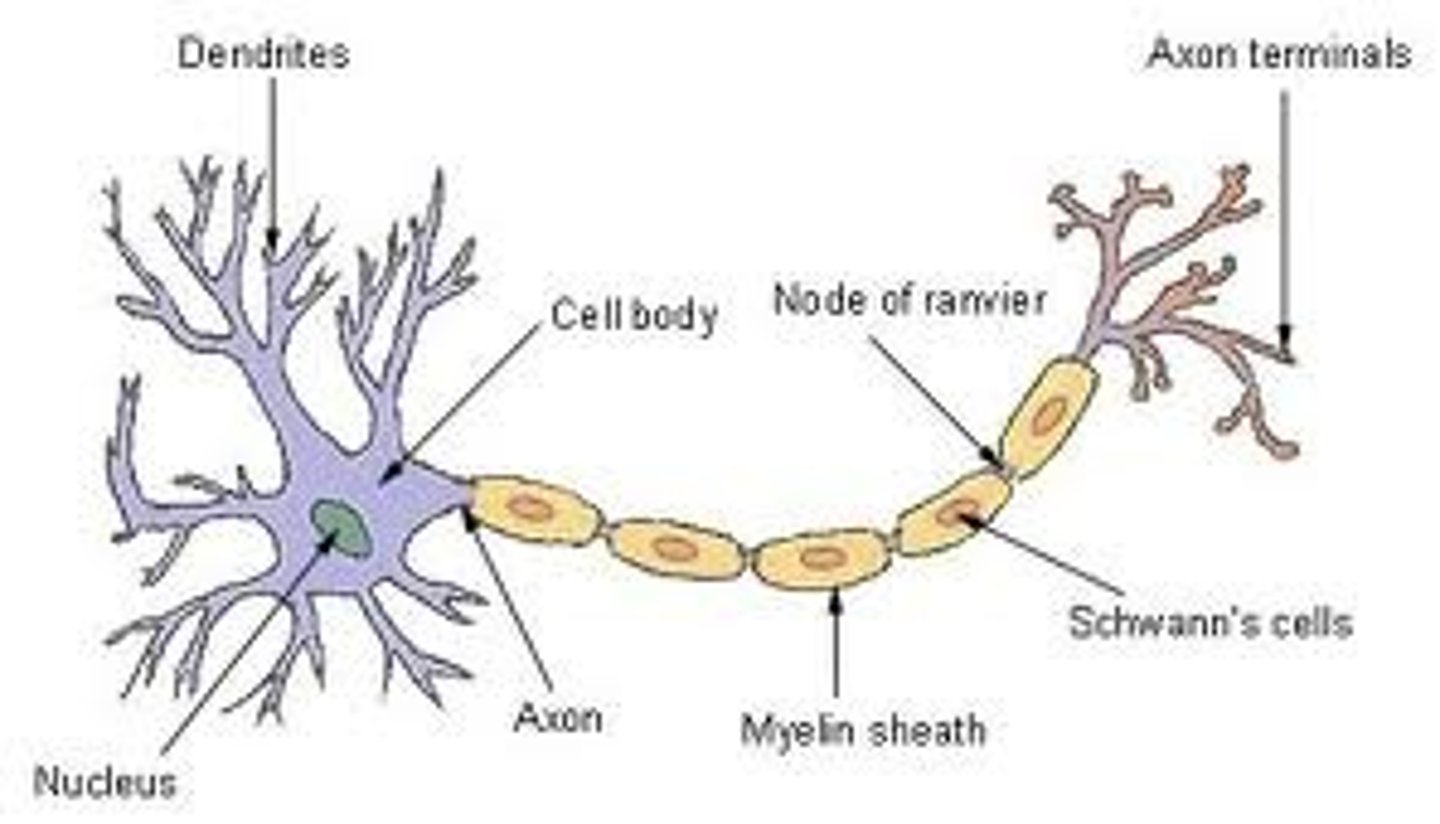
what is the peripheral nervous system?
the sensory and motor neurons that connect the central nervous system to the rest of the body.
subdivided into autonomic and somatic NS
what is a nerve?
a bundle of axons (transmit impulses away from cell body) /multiple neurones in the peripheral nervous system.
has cell body (contains nucleus + organelles), dendrites (conduct impulses toward cell body)
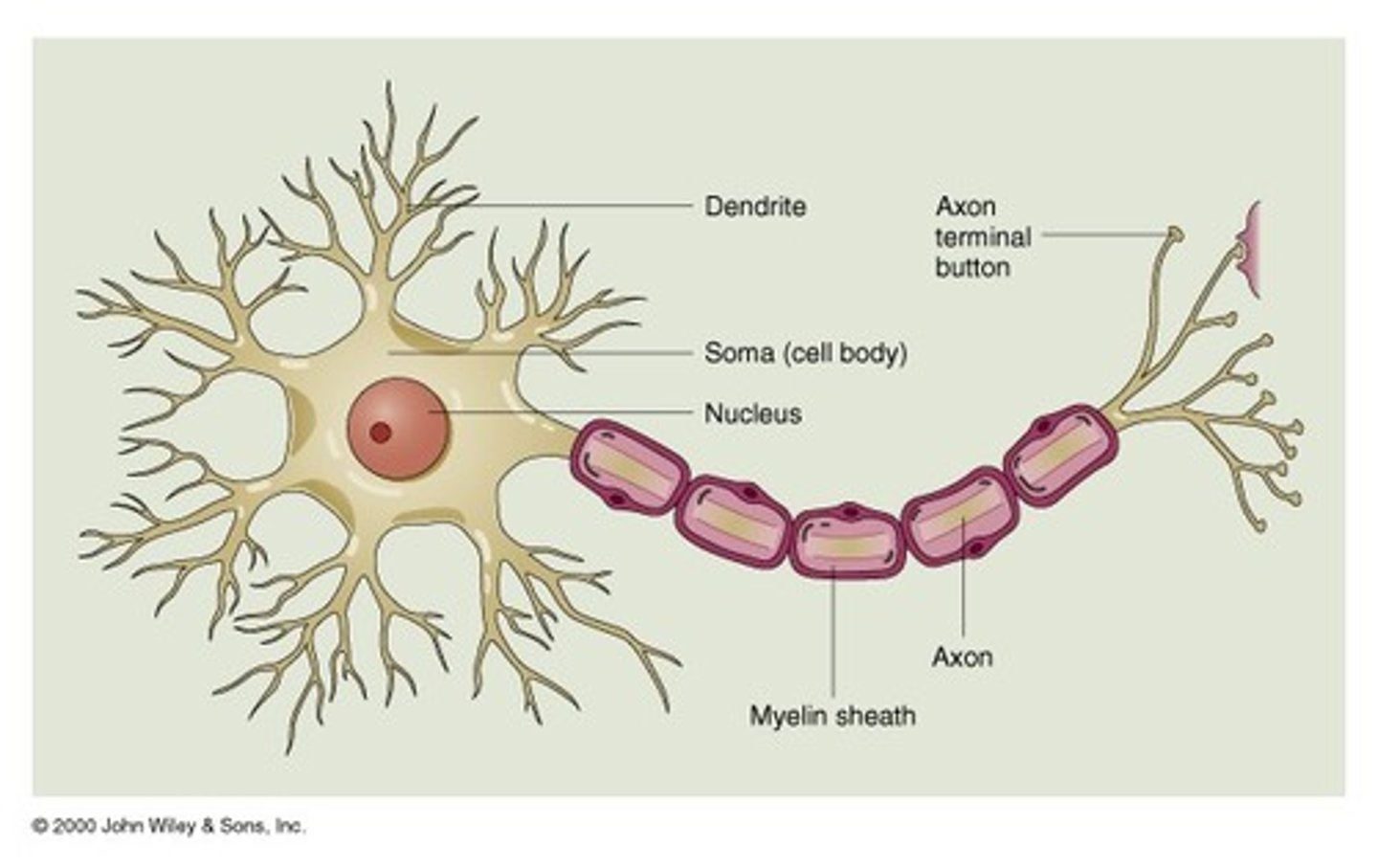
general structure, location of cell body relative to CNS, dendrites (what do they synapse with), axons, function -- MOTOR NEURONES
-short dendrites, long axon + has schwann cells, nodes of Ranvier, myelin sheath
-cell body always situated within CNS
-dendrites synapse with other neurones in CNS
-axon extends out, conducting impulses from CNS to effectors
-function to conduct impulses from CNS to effectors
general structure, location of cell body relative to CNS, dendrites (what do they synapse with), axons, function -- RELAY NEURONES
-short dendrites long axon
-mostly found in CNS
-dendrites synapse with other neurones in CNS
-axons synapse with other neurones
-connect sensory neurones with motor neurones
general structure, location of cell body relative to CNS, dendrites (what do they synapse with), axons, function -- SENSORY NEURONES
-long dendrites, short axon + schwann cells, nodes of ranvier, myelin sheath
-cell body + dendrites outside CNS. cell body is in dorsal root ganglion at entrance root to spinal cord
-dendrites synapse with sensory receptor cells
-axons synapse with other neurones in CNS
-carry impulses from sensory cells to CNS
what are schwann cells/myelin sheath and what do they do?
-myelin sheath wrap around axons
-myelin sheath affects how quickly nerve impulses pass along axon = increase speed of neurotransmission
-not all animals have myelinated axons
what is the importance of dendrites?
-{form synapses/connections} with other neurones
-{integrate/receive} impulses from other neurones
-involved in summation
-{propagate a signal/initiate an action potential} to the {cell body/axon}
how reflex arc works
1.receptors detect stimulus and generate nerve impulse
2.sensory neurones conduct nerve impulse to CNS along sensory pathway
3.sensory neurones enter spinal cord through dorsal route
4.sensory neurone forms synapse with relay neurone
5.relay neurone forms a synapse with a motor neurone that leaves spinal cord through ventral route
6.motor neurone carries impulse to an effector (muscle or gland) which produces a response
understand how the pupil dilates and contracts - the pupil reflex main ideas (muscles in it + what NS they are controlled by etc)
-the iris controls size of pupil.
-it contains a pair of antagonistic muscles = radial and circular muscles. these are controlled by autonomic NS
-radial muscles controlled by sympathetic reflex and circular controlled by parasympathetic reflex
-one reflex dilates pupil the other constricts
what happens when the pupil is constricted? and when it is dilated? (impulse from what NS, what muscles are relaxed and contracted, how much light let in?)
when constricted (bright light) = parasympathetic nerve impulse = radial muscles relax, circular contract = less light into eye
when dilated (dim light) = sympathetic nerve impulse = radial muscles contract, circular muscles relax = more light enter the eye
Controlling pupil size (5 steps)
1. high light levels strike photoreceptors in retina
2.nerve impulses sent along sensory neurone in optic nerve to CNS
3.impulse passes along parasympathetic motor neurones to circular muscles
4.circular muscles contract and radial relax
5. pupil constricts = less light enters eye
this is an innate autonomic response
what is the resting potential? and what is it controlled by?
-the resting potential difference is -70mV
-it is maintained by the sodium-potassium pump in the cell membrane of the axon. ions pumped against conc gradient = require energy via ATP
-electrical gradient due to difference in charge on either side of the axon membrane resulting from potassium ion diffusion
how is a resting potential maintained?
1.sodium potassium pump maintains a conc gradient between Na+ and K+
2.potassium (K+) ions diffuse down conc gradient, out of potassium channels, making outside of membrane positive and this inside more negative. this creates potential difference
3. potential difference will pull K+ back into the cell.
4.at -70mV potential difference, the two gradients counteract each other and there is no net movement of K+. = electrochemical equilibrium
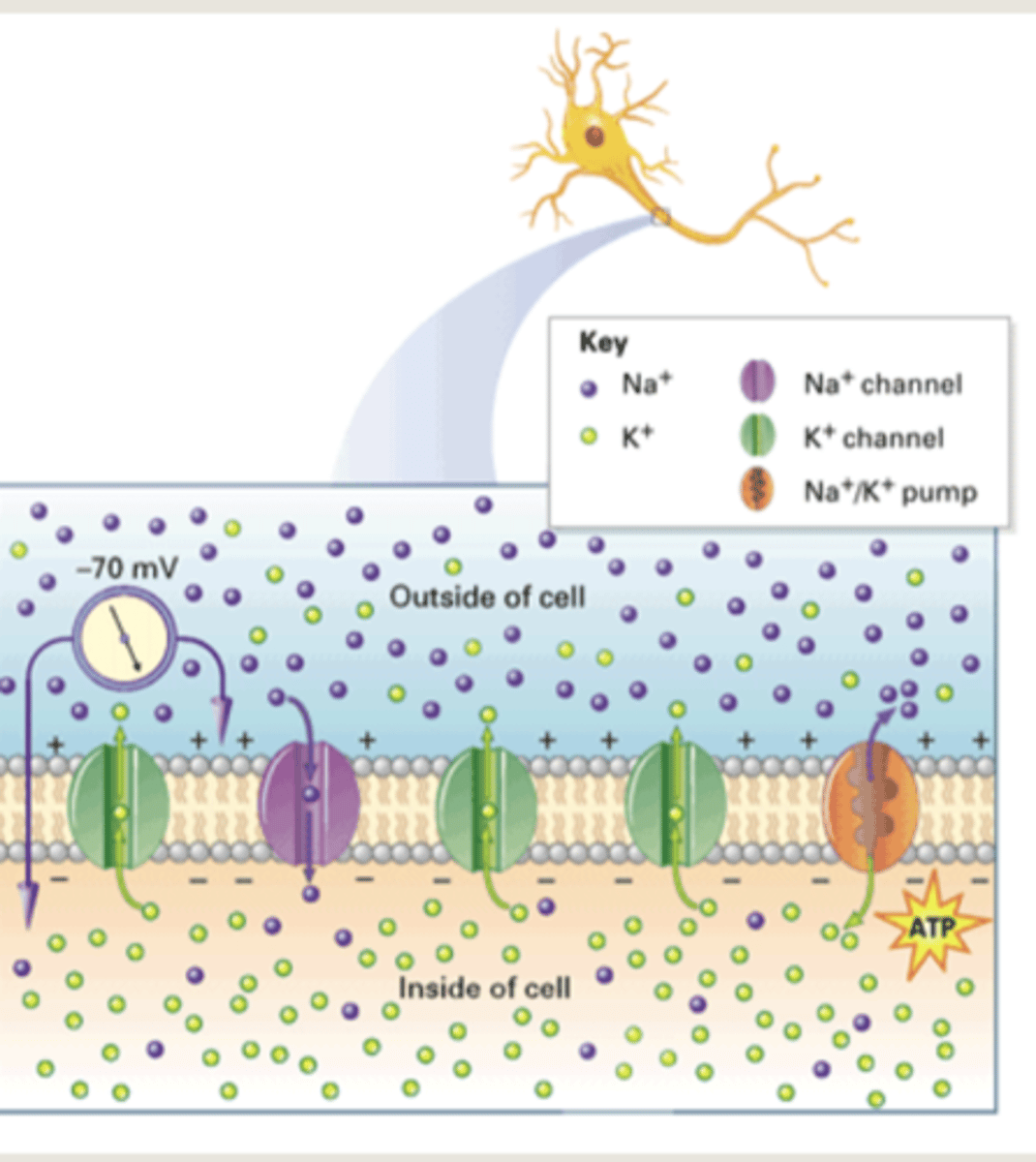
explain how passive potassium channels are involved in establishing the resting potential of an axon (4)
-passive channels allow potassium ions to move down conc gradient
-potassium ions move from inside to outside the axon
-movement through passive channels is reduced by a negative charge inside the axon
-no net movement of potassium ions through these channels at the resting potential
stages of an action potential
1. depolarization
2. repolarization
3. hyperpolarization
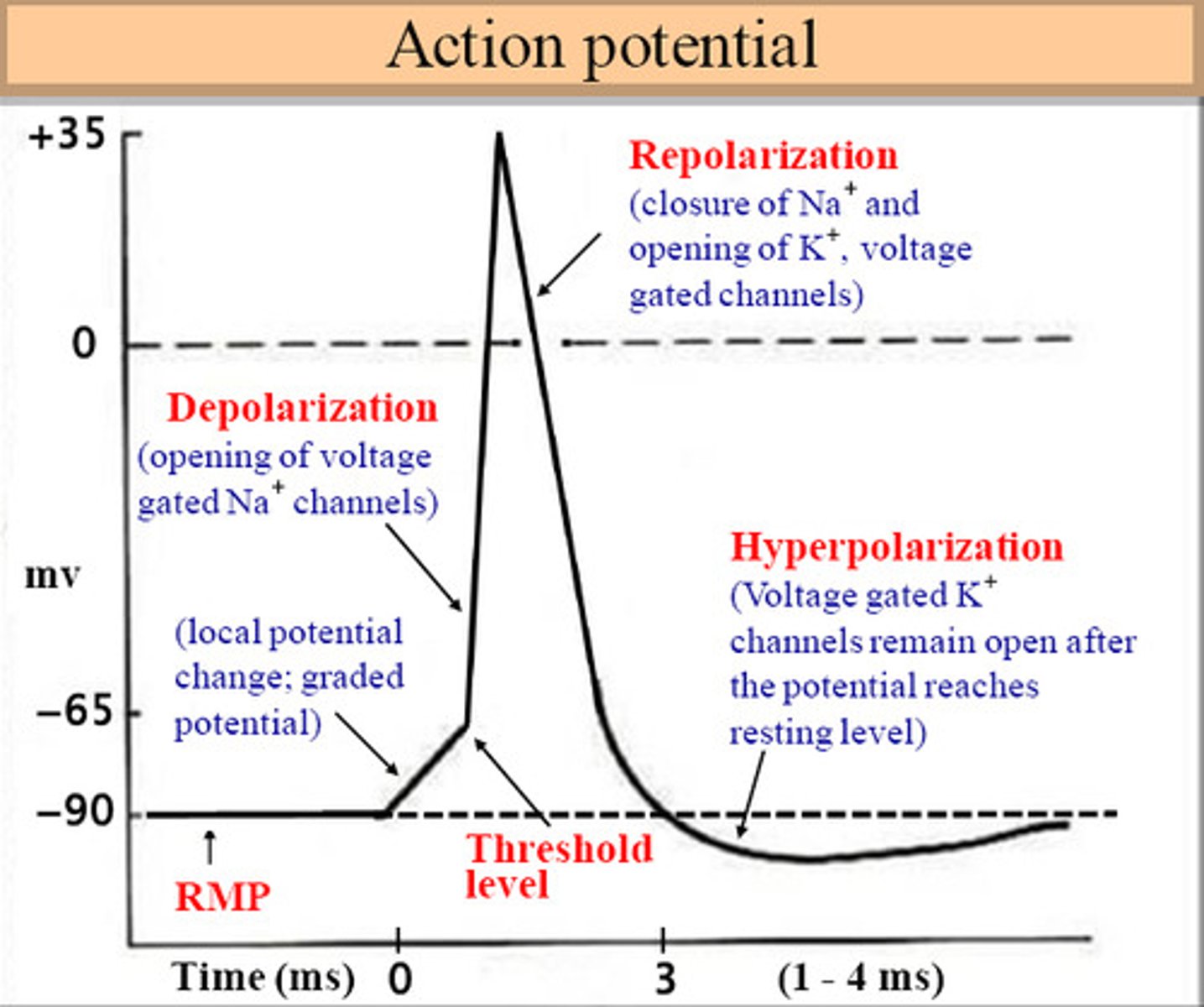
what happens during depolarisation?
1. Stimulus→facilitated diffusion of Na+ ions into cell down electrochemical gradient.
2. p.d. across membrane = now more positive.
3. If membrane reaches threshold potential (-50mV), voltage-gated Na+ channels open.
4. influx of Na+ ions reverses p.d. to +40mV. (leads to opening of more voltage gated Na+ channels to open, like a positive feedback)
what happens during repolarisation?
1. Voltage-gated Na+ channels close and voltage-gated K+ channels open.
2. Facilitated diffusion of K+ ions out of cell down electrochemical gradient.
3. p.d. across membrane becomes more negative (repolarises)
what happends during hyperpolarisation?
1. membrane is highly permeable to K+ so more K+ moves out than at resting potential = p.d. becomes more negative than resting potential
2.resting potential re-establishes as voltage-gated K+ channels close and K+ diffuses back into axon.
what is the all or nothing principle?
-Any stimulus that causes the membrane to reach threshold potential will generate an action potential. All action potentials have same magnitude.
how is the resting potential restored after lots of action potentials occur in the neurone and the sodium ion conc inside the cell rises significantly?
the sodium-potassium pumps start to function, restoring the original ion concs across the cell membrane
how is the impulse passed along an axon?
action potential doesn't actually travel along the axon, but instead triggers a sequence of action potentials along the axon
stages in how a nerve impulse is conducted along an axon - what are the order of events
-resting potential
-Stimulation/first action potential
-second action potential
-third action potential
stages in how a nerve impulse is conducted along an axon - what is resting potential? (what is the charges on inside and outside + ion concs)
-at resting potential there is positive charge outside of the membrane and negative inside = high Na+ conc outside, high K+ conc inside
stages in how a nerve impulse is conducted along an axon - stimulation/first action potential (what happens when a nerve is stimulated?)
1.voltage-dependent Na+ channels open = depolarisation of membrane
2.localised electrical currents generated as Na+ flow to adjacent part of membrane
3.movment of Na+ to adjacent polarised region causes change in electrical charge (p.d.) across membrane (this initiates the 2nd action potential)
stages in how a nerve impulse is conducted along an axon - the second action potential (what happens after the first action potential initiates the 2nd action potential)
1.at site of 1st action potential, voltage-dependent Na+ channels close = voltage-dependent K+ channels open
2.K+ leave axon = repolarising membrane = hyperpolarisation
stages in how a nerve impulse is conducted along an axon - the third action potential (after initiated by 2nd)
1.3rd action potential initiated by 2nd action potential
2.these local currents cause impulse to move along axon
3.at site of 1st action potential K+ ions diffuse back into axon, restoring resting potential
What is the refractory period?
a period immediately following stimulation during which a nerve or muscle is unresponsive to further stimulation.
-new action potential cant be generated for 5ms as voltage-gated Na+ channels remain inactivated
-it lasts until the voltage-dependent Na+ and K+ channels have returned to normal resting state.
-THE REFRACTORY PERIOD ENSURES IMPULSES CAN ONLY TRAVEL IN ONE DIRECTION
Are impulses different sizes?
the all or nothing effect means that the size of the stimulus, assuming it is above the threshold, has no effect on the size of the action potential. the size of the stimulus effects:
-frequency of impulses
-the number of neurones in a nerve that are conducting impulses
explain how myelination increased speed of transmission of nerve impulses in a sensory neurone. (5)-
-{neurone cell membrane exposed/no myelination} at nodes of Ranvier
-nodes of Ranvier are site of clusters of {sodium-gated channel proteins/potassium channels}
-which open/close when impulse arrives
-allowing depolarisation at nodes of Ranvier (nodes are the only place depolarisation can occur)
-myelin acts as electrical insulator
-myelin sheath is made up of Schwann cells
-impulse/depolarisation jumps from one node to the next
-this is called {saltatory conduction}
-this happens between the myelin layers of the Schwann cells
what does the synthesis of neurotransmitters and packaging them into vesicles require lots of?
it requires the presynaptic cell to expend lots of energy to produce the neurotransmitter and package it into vesicles.
what are the main neurotransmitters you should know about? most important is in caps
-ACETYLCHOLINE (used in voluntary nervous systems so involve motor neurones and muscles. but also in some autonomic systems e.g decreasing heart rate)
-Noradrenaline (released from adrenal glands, used in fight or flight, controls heart rate + energy release from fat)
-Dopamine (main neurotransmitter in brain. involved in increasing rate and blood pressure)
what are the 3 stages of synaptic transmission
-neurotransmitter release
-stimulation of postsynaptic neurone
-inactivation of the neurotransmitter
stage 1 of synaptic transmission in detail - neurotransmitter release (using example of acetylcholine)
1.action potential arrives at presynaptic membrane
2.membrane depolarises, calcium ion channels open (increasing membrane permeability to Ca^2+), and Ca^2+ enter the neurone
3.increased Ca^2+ conc causes synaptic vesicles containing neurotransmitters to fuse with presynaptic membrane and release acetylcholine into synaptic cleft via exocytosis
stage 2 of synaptic transmission in detail (using acetylcholine as an example)- how is the postsynaptic membrane stimulated?
1.acetylcholine/neurotransmitter take 0.5ms to diffuse across cleft
2.receptor proteins have a complementary binding site for acetylcholine
3.binding causes cation channels to open to allow Na+ to flow in = depolarisation of postsynaptic membrane and action potential occurs if depolarisation is sufficient
during the stimulation of the postsynaptic membrane, the extent of depolarisation depends on what?
-the amount of neurotransmitter that reaches it
-the frequency of presynaptic impulses
-the number of functioning receptors in the postsynaptic membrane
stage 3 of synaptic transmission in detail (using acetylcholine as an example) - how are neurotransmitters inactivated (2 general ideas and one specific way that acetylcholine is inactivated, hint it uses an enzyme)
-some neurotransmitters actively taken back up by presynaptic membrane to be used again (REUPTAKE)
-some rapidly diffuse away
---acetylcholine broken down by specific enzyme, acetylcholinesterase = can no longer bind to receptors
what are the roles of synapses in nerve pathways?
-control of nerve pathways, allowing flexibility of response
-integration of info from different neurones, allowing a coordinated response
post synaptic cell is likely to be receiving input from many synapses at the same time, what are the two main factors that determine if postsynaptic membrane will depolarise?
-type of synapse (excitatory or inhibitory)
-number of impulses received
define summation and and name the 2 types
Neurotransmitter from several sub-threshold impulses accumulates to generate action potential:
-spatial summation
-temporal summation
NB no summation at neuromuscular junctions.
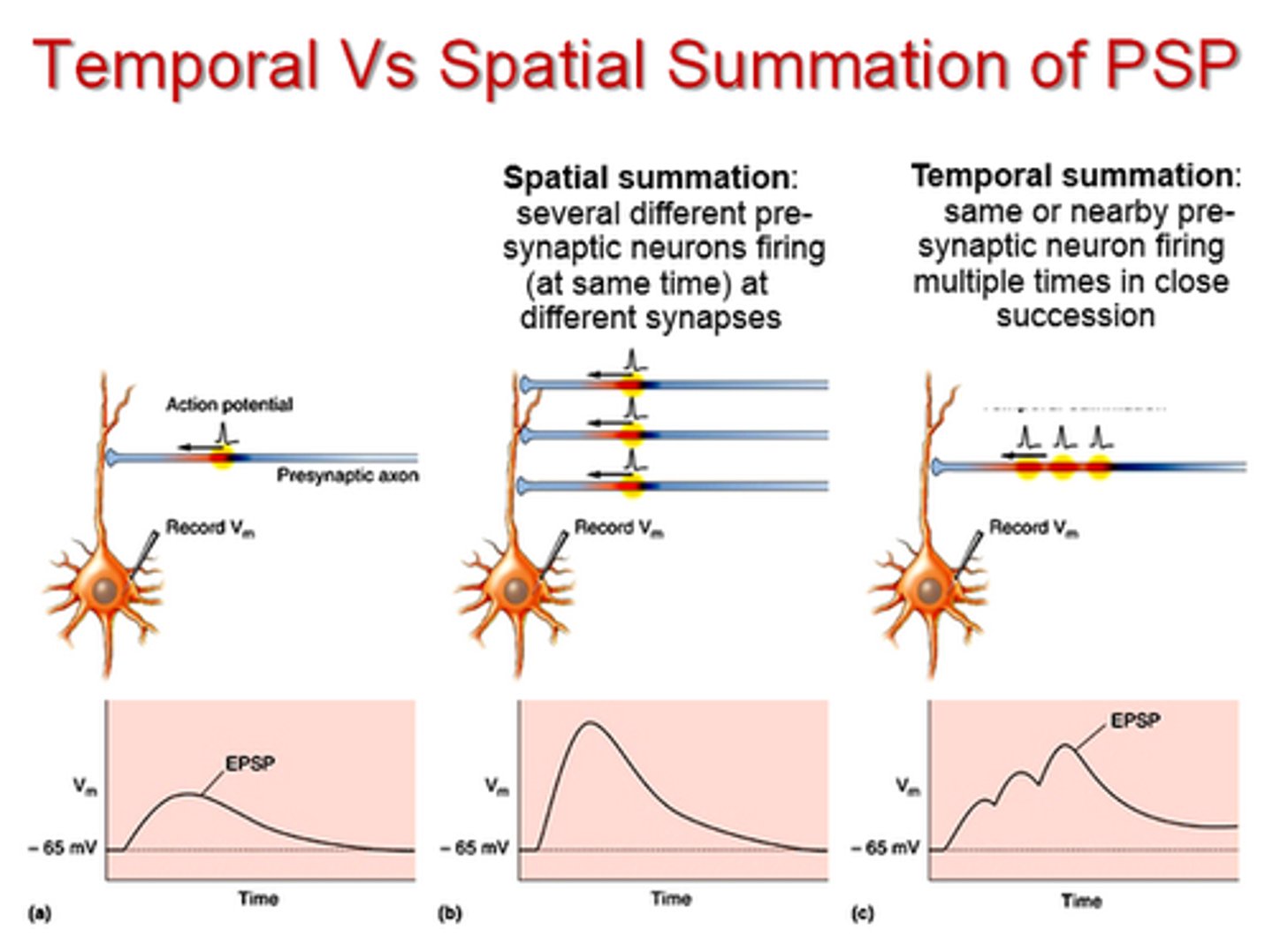
what is the difference between temporal and spatial summation?
--temporal summation = several impulses arrive at synapse after travelling along a single neurone one after another (combined release of neurotransmitter causes depolarisation)
--spatial = impulses from different synapses, usually from different neurones
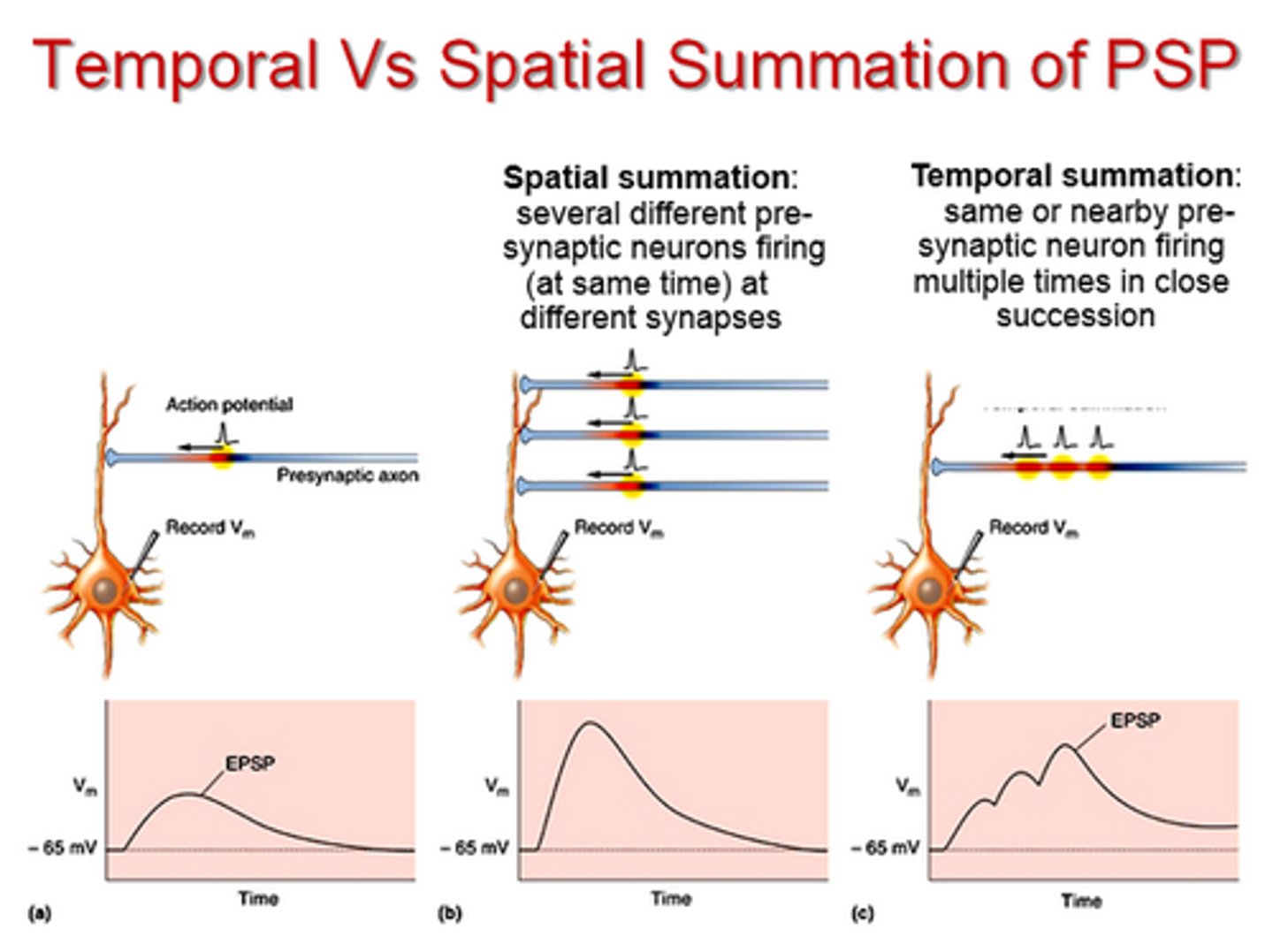
what are excitatory synapses?
synapses that make the post synaptic membrane more permeable to Na+ ions = Na+ diffuse in, causing an action potential
what are inhibitory synapses?
-make it less likely an action potential in postsynaptic cell.
-neurotransmitters from these synapses open chloride and potassium ion channels
-Cl- carry negative charge into postsynaptic cell
-K+ carries positive charge out of cell
-results in greater potential diff across membrane = hyperpolarisation
-hyperpolarisation makes depolarisation less likely
Describe and explain the sequence of events that occurs in a synapse, after a neurostransmitter has been released (5)
-neurotransmitter diffuses across gap
-binds to receptors on post-synaptic membrane
-{gate-channels opening/Na+ travels through post synaptic membrane}
-causing a depolarisation
-action potential set up in post-synaptic membrane
-ideas of temporal or spatial summation
-idea that allows coordination/one way flow of information
-neurotransmitter broken down by enzyme
contrast nervous and hormonal control in animals: 5 categories
nervous control:
-electrical transmission by nerve impulses and chemical transmission at synapses
-fast acting
-associated with short term changes e.g muscle contraction
-action potential carried by neurones
-response is very local, e.g specific muscle or gland
--Hormonal control--
-chemical transmission through the blood
-slower acting
-can control long-term changes e.g growth
-blood carries the hormone to all cells, but only target cells respond
-response can be widespread
what is the basic idea of how a receptor works?
-at rest = membrane has resting potential
-stimulation causes depolarisation
-depolarisation relayed across synapse
compare and contrast the role of photoreceptors in the retina - include location, optimal light conditions, visual acuity, colour/wavelength sensitivity, type of vision, number of types, relative abundance - ROD CELLS
Rod cells:
-periphery of retina
-low/dim light but also bright light = optimal
-lower resolution
-sensitive to all wavelengths
-black and white vision
-only one type (all contain rhodopsin)
- relative abundance is ~20 (rod cells are more abundant)
compare and contrast the role of photoreceptors in the retina - include location, optimal light conditions, visual acuity, colour/wavelength sensitivity, type of vision, number of types, relative abundance - CONE CELLS
Cone cells:
-centre of retina, within fovea
-bright light = optimal
-high resolution as there is one cone cell per bipolar cell
-only sensitive to 3 wavelengths (red,blue,green)
-colour vision
-there are 3 types of cone cell
-relative abundance is 1/less abundant than rods
what is the structure of the retina?
-in an arrangement of 3 layers.
-it appears backward
-the rods and cones synapse with bipolar neurone cells
-bipolar neurone synapse with ganglion neurones whos axons make up the optic nerve.
-LIGHT HITTING THE RETINA HAS TO PASS THROUGH THE LAYERS OF NEURONES BEFORE REACHING THE RODS AND CONES.
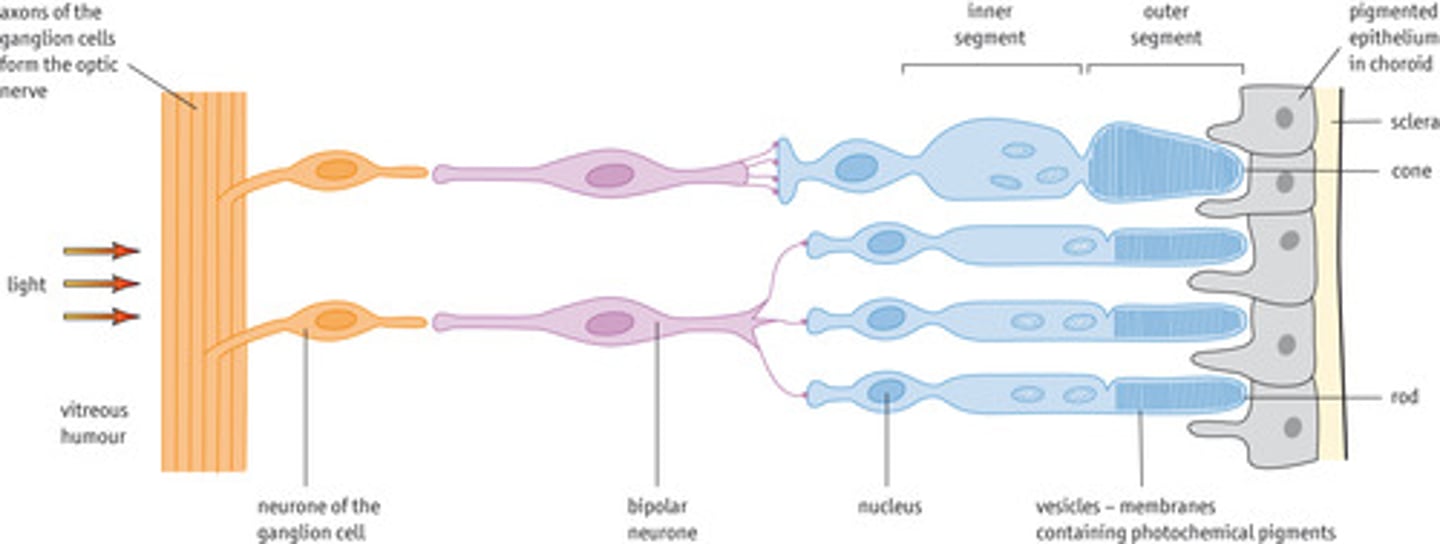
how does light stimulate photoreceptor cells? (talk about both rods and cones and then specifically rods)
-in both rods and cones, a photochemical pigment absorbs the light resulting in chemical change.
-in rods, there is a pigment called rhodopsin.
What occurs to rod cells in the dark?
-in the dark, sodium ions (Na+) flow into outer segment of rods through {non-specific cation channels}
-Na+ move down conc gradient into inner segment where Na+ are continually pumped back out (via active transport)
-influx of Na+ produces a {depolarisation}
-triggers the release of {glutamate (neurotransmitter)} which inhibits the bipolar neurone and stops it from doplarising = no action potential
Why is dark adaptation important?
it is important that rhodopsin is reformed so that other stimuli can be recieved
what happens to rod cells in light/describe how light causes a change in the voltage across the cell surface membrane of a rod cell (EQ worth 4) - uses some info from textbook
-light intensity increase
-light absorbed by rhodopsin
-rhodopsin {changes shape}
-rhodopsin converted/broken down into {retinal and opsin}(called bleaching)
-opsin binds with cell surface membrane/ (opsin activates a series of reactions ending in hydrolysis of a cyclic nucleotide molecule attached to cation channel in outer segment)
-closes cation channels
-fewer Na+ enter rod cells
-inner segment pumps Na+ out
-{hyperpolarisation} occurs and release of glutamate stops
-means {depolarisation} of bipolar neurone can occur
-means {action potential is generated}
what happens in the eye to allow it to become adapted to the dark when moving from bright to dim light?
-when rhodopsin breaks down it must be reformed so that another stimulus can be detected by rod cells
-opsin uncouples from rod cell surface membrane
-trans retinal converts to cis retinal
-rhodopsin is reformed from opsin and retinal with energy from ATP
-this results in dark adaptation
-increased permeability of cell membrane to Na+/Na+ enters rod cell
-hyperpolarisation decreases/slight depolarisation
-glutamate released
what is a tropism, and specifically a phototropsim?
-tropism = growth in response to stimulus
-phototropism = growth in response to stimulus of light.
how is coordination achieved in plants? (because they lack a nervous system)
-use chemicals to coordinate growth, development and responses to the environment.
-the chemicals can be: plant hormones, plant growth regulators, plant growth substances
-these are produced at low concentrations and transported to where they cause a response
-the first plant growth substance to be discovered were AUXINS
How does IAA move around the plant?
- Diffusion and active transport (via carrier proteins) over short distances
- In the phloem over longer distances
how does the auxin IAA cause cause changes to transcription
-IAA/auxins bind to protein receptors in target cells
-activated intracellular second messenger signal molecules
--this activates transcription factors. these control:
-control transcription of auxin-related genes
-therefore, proteins produced which bring about metabolic changes = cell expansion, cell division, cell differentiation
How does IAA cause cell elongation?
it loosens the structure of the cell wall
how does |AA loosen the cell wall?
-IAA accumulates on shaded side of shoot
-IAA activate genes that code for protein pumps that move H+ ions out of the cytoplasm and into the cell wall.
-low pH/ ACIDIFCATION activates proteins called {expansins}
-expansins disrupt bonds that hold cellulose microfibrils and hemicelluloses together.
how does acidification (caused by IAA) of cell wall lead to elongation?
-acidification of cell wall = increase pd across cell membrane = increase uptake of ions into cell.
-increased ion conc = increased water uptake by osmosis = cell swells = elongation
auxins can be used to kill unwanted plants such as weeds growing in grass. auxin stimulate the weeds to grow rapidly . Suggest an explanation for how auxins stimulate the weeds to grow rapidly but not the grass (there are 3 explanations) (2)
1.positive tropism
-IAA diffuses away from light source
-IAA accumulates in {cells/tissues} further from light
-IAA stimulates elongation causing growth toward light
2.chemicals
-produced in cells
-they move away from site of production
-effect may be distant from production site
-long term effect
-involved in gene activation
3.-idea that weeds affected because they may be more sensitive to auxins, or take up more
-idea that auxin/IAA causes cell elongation
what are phytochromes?
Photoreceptors that plants use to detect light. They are molecules that absorb red (phytchrome red/Pr) and far red light (phytochrome far red/Pfr)
what does red light do to Pr? and what does far red light do to Pfr
-red light converts Pr to Pfr
-absorbtion of far red light converts Pfr back to Pr
what does Pfr regulate in plants?
developmental processes
what responses are regulated by phytochromes?
-seed germination
-stem elongation
-leaf expansion
-chlorophyll formation
-flowering
how do phytochromes trigger seed germination?/what experiments showed this
-experiments with lettuce indicate that a flash of red light will trigger germination, but if followed by flash of far red light, germination was inhibited.
-RED LIGHT TRIGGERS GERMINATION = Pr converted to Pfr
-Pfr isomer needed for germination
how do phytochromes trigger greening?
-in light, phytochromes promote:
-development of primary leaves, leaf unrolling and production of pigments e.g chlorophyll
-in light phytochromes also inhibit the elongation of internodes (in darkness plants grow to be longer/leggy and less green)
what is greening?
ones shoot broken through soil into sunlight, plant undergoes changes in both form + biochemistry, this is called greening
how do phytochromes trigger flowering?
-the photoperiod (relative length of day and night) is an environmental cue that determines time of flowering.
-ratio of Pr to Pfr enables plant to determine length of day and night.
-MORE LIGHT = Pfr to Pr
-long winter nights =long darkness = more Pfr converted back to Pr
-short summer nights = some Pfr still present in the morning
what are long day plants? (to do with how phytochromes trigger flowering)
e.g strawberries or oats
-only flower when day length exceed critical value
-flower when uninterrupted darkness is less than 12 hours
-Pfr needed to stimulate flowering
what are short day plants?
-plants that require 12 or more hours of darkness to convert Pfr to Pr
-Pfr inhibits flowering in these short day plants
how are phytochromes involved in switching genes on an off?
-exposure to light causes phytochrome molecule to change shape
-activated phytochrome interacts with other proteins (can bind to them or disrupt binding)
-signal proteins act as transcription factors or activate transcription factors that allow transcription of light regulated genes
-transcription + translation of proteins results in a plants response to light
what other environmental cues influence plant growth?
-gravity, touch and mechanical stress
-under soil, light cant be a trigger for growth, so gravity must be a stimulus e.g shoots grow up, roots grow down
-mechanical stress activated signal molecules which control genes for growth factors
what is the outer layer of the brain? and what is it composed of?
-the outer layer is the cerebral cortex
-grey+ highly folded
-composed mainly of nerve cell bodies, synapses and dendrites
-it is known as the GREY MATTER
how many hemispheres is the cerebral cortex broken into and how many different lobes are each hemisphere composed of?
-cerebral cortex is divided into 2 hemisphere, each composed of 4 lobes:
-frontal lobe
-temporal lobe
-parietal lobe
-occipital lobe
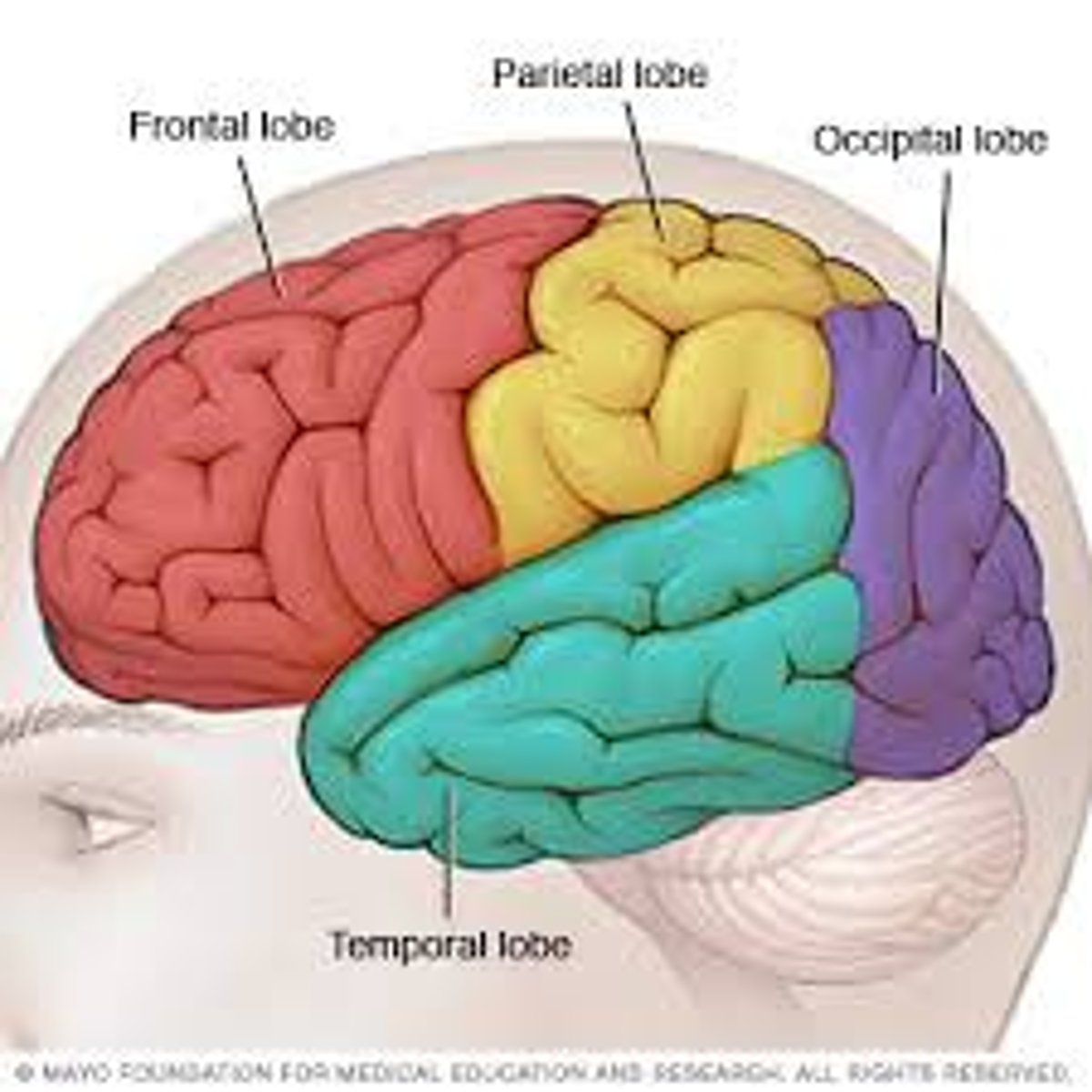
what are the roles of the frontal lobe?
1-Problem solving (prefrontal area)
2-Emotional traits
3-Reasoning
4-Speech production (Broca's area)
5-Voluntary motor control
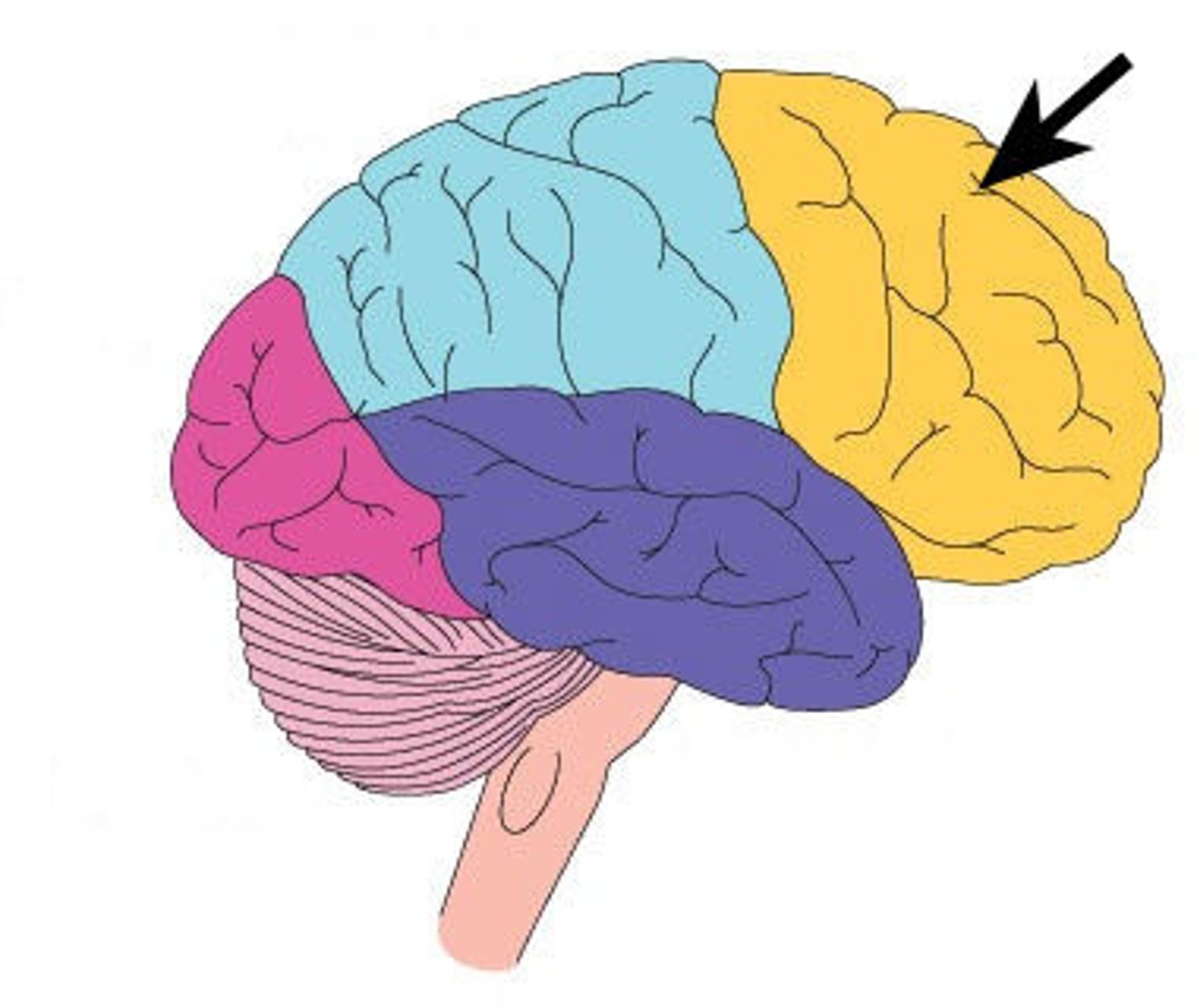
what are the roles of the temporal lobe?
1-Understanding language (Wernicke's area)
2-Behaviour
3-Memory
4-Hearing
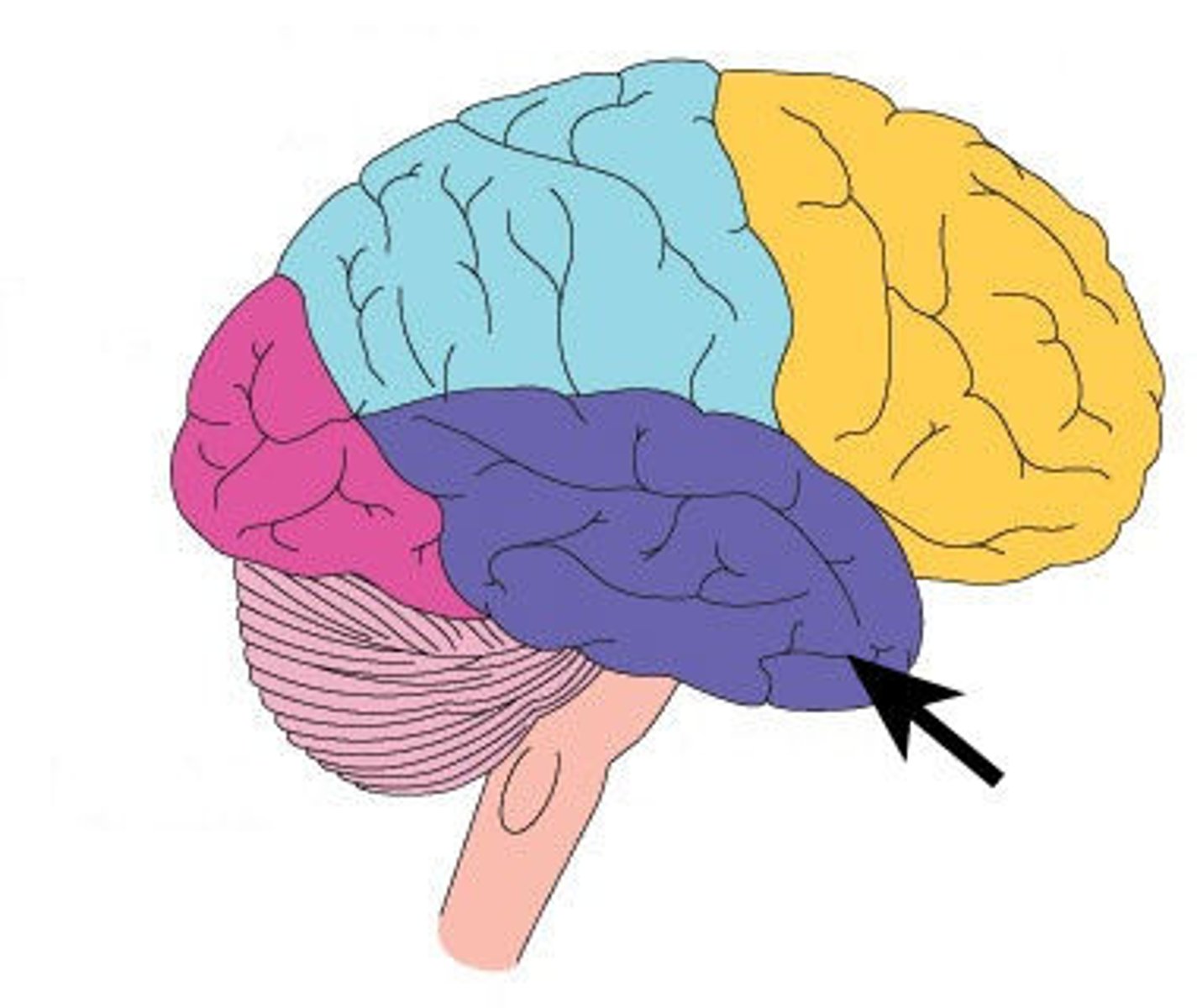
what are the roles of the parietal lobe?
-touch perception
-body orientation + sensation
-movement
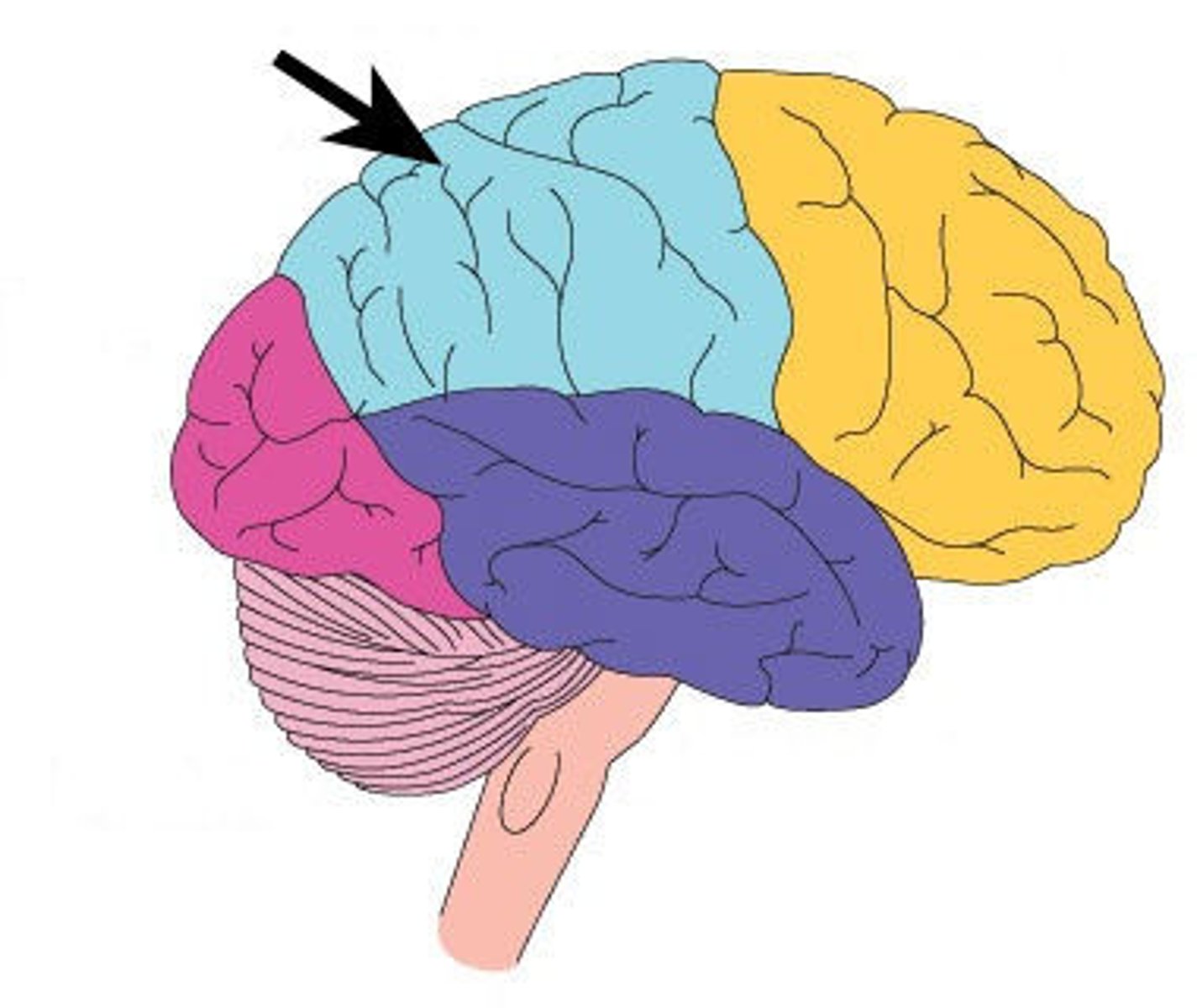
what are the roles of the occipital lobe?
-sight (visual cortex)
-visual perception e,g colour, shape, recognition, perspective
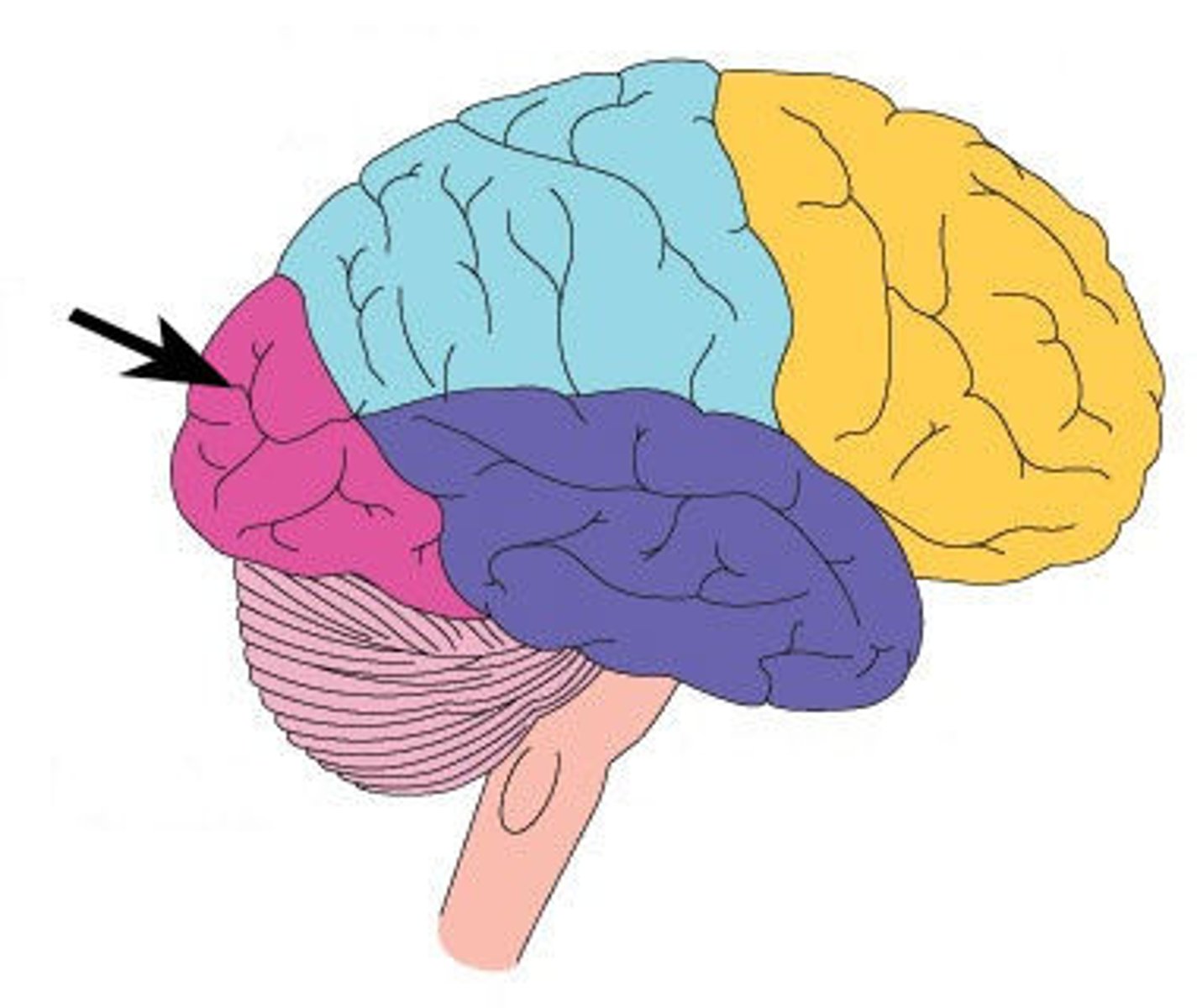
what is the inner layer of the brain? and what is it composed of?
-WHITE MATTER
-composed of axons that connect neurones
-white because of myelin sheath
what is the role of the hypothalamus?
- Maintains homeostasis
- (thermoregulatory centre) Regulates core body and skin temperature, heart rate, blood pressure
- acts as an endocrine gland that Secretes hormones that act on pituitary gland
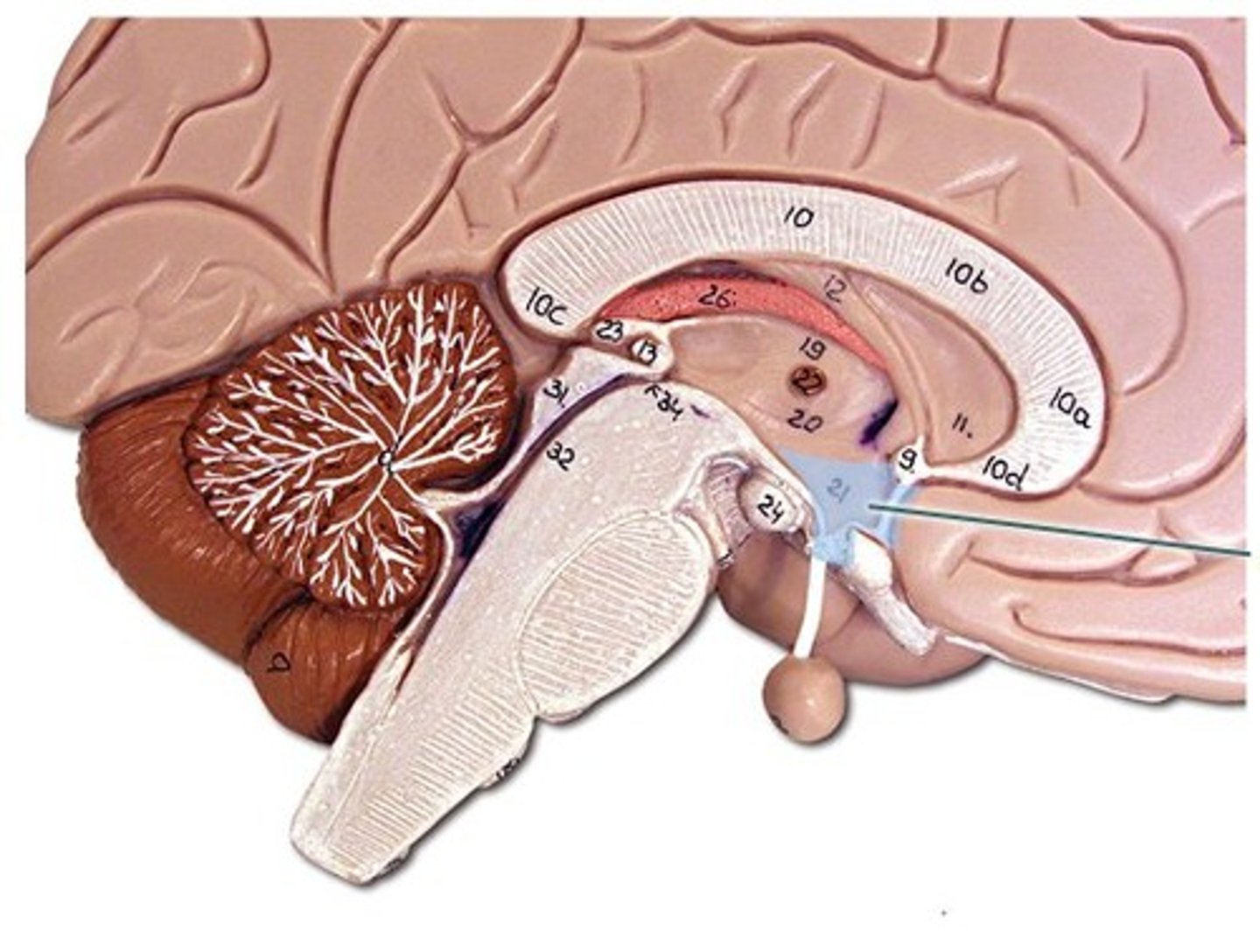
what is the role of the cerebellum?
-responsible for balance
-coordinated movement as it is being carried out, receiving info from the primary motor cortex, muscles and joints

what is the role of the medulla oblongata (within the brain stem)
connects with CNS to send messages down spinal cord.
--medulla carries out complex functions such as:
-control of movement, arousal, sleep
-relay sensory info from organs
-blood pressure regulation
--also controls some activites in the autonomic NS:
-movment
-breathing rate
-heart rate
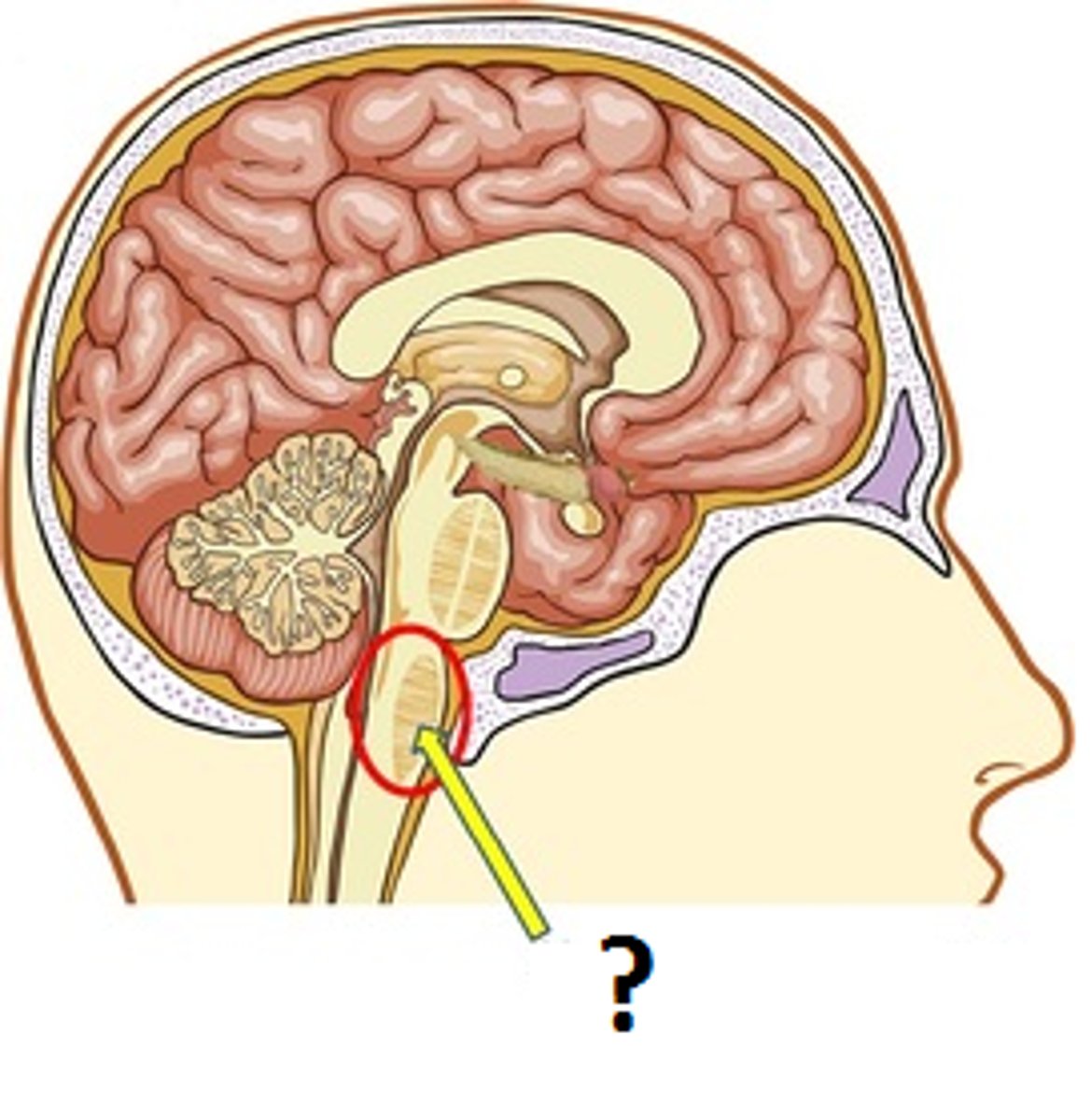
how have brain scanning techniques been beneficial?
have improved the ability of doctors to find out what is wrong and to monitor treatment without invasive procedures
How do CT scans work?
-uses X-rays
-rotate around patients to pass through tissue from diff angles.
-each X-ray beam is reduced in strength according to density of tissue
-X-rays are detected and used to produce an image of a thin slice of the brain,
-different soft tissues in the brain can be seen
how does MRI work?
-uses a magnetic field + radio waves
-hydrogen in water inside tissues line up with the magnetic field
-energy is released by changing alignment of H nuclei
-MRI detects energy from hydrogen/protons
-creates an image
how does fMRI work?
-fMRI detects {blood flow/oxygen use} in the brain
-increased brain activity results in increased {blood flow/demand for O2/aerobic respiration} in the area of activity
-{oxyhaemoglobin} absorbs fewer radio waves/fMRI detects where less signal absorbed
-the less radio signal absorbed the higher the activity
how does PET work?
-PET uses radioactive {markers/tracers/glucose}, that emit positrons
-positrons travel away from nucleus until it collides with an electron
-{production of gamma rays}
-providing a 3D image
compare CT and MRI scans
CT:
-(ionising) X-rays
-less safety aspect of X-rays
-{lower image resolution in CT}
-can only identify {larger/main structures}
-gives 2D + 3D images
-CT less expensive
-image is one point in time
--MRI:
-higher resolution in MRI
-Can identify smaller structures
-gives 2D/3D images
-MRI more expensive
-MRI is noisy
-patient needs to keep still
-not good for people with metal implants (due to magnetic field)
-image at one point in time
compare fRMI and PET
fMRI:
-views brain activity directly
-measures activity over a period of time by taking up to 4 images per sec
-no need to use special dyes like some techniques
--PET:
-3D image
-very expensive
-not safe so can be done a maximum of 1-2 times a year
what are critical windows for development?
stages in the lifespan of an organism where it is particularly sensitive to a specific stimulus which is required for the organism to develop properly
what happens during the critical period/window so that mammals can develop their visual capacities to the full?
IF A SPECIFIC STIMULUS IS RECIEVED:
-the visual cortex develops
-axons from the retina grow through thalamus where they form synapses with other neurones and then develop
-axons grow toward the visual cortex in the occipital lobe
-ocular dominance columns within the visual cortex have an alternating patterns, where stimulus is received from the left and then right eye
-this gives the brain the ability to create 3D images of what your eyes see
describe the role of visual stimulation on the development of the visual cortex during the critical period
-ocular dominance columns develop in the visual cortex
-neurones form synapses with these {cells/columns}
-{stimuli/action potentials/impulses} travel along neurones required to strengthen connections (with cells of ocular dominance columns)
-stimulation during the critical period is needed to form (effective) connections in the visual cortex
why are animal models useful for research into human brain development and function?
-easy to obtain
-easy to breed
-have short life cycles
-small adult size/smaller than humans
what are the 3 ethical standpoints on use of animals for scientific research?
-utilitarianism
-animal rights
-animal welfare
ethical standpoints on use of animals for scientific research - utilitarianism
-the right course of action is one that maximised amount of overall happiness or pleasure in the world
-benefits to humans must outweigh animal harm
ethical standpoints on use of animals for scientific research -animal rights
animals have rights + there is a lack of consent
ethical standpoints on use of animals for scientific research - animal welfare
treated as well as possible creating least harm with strict guidelines and only if there are no other alternatives
what is a limitation of the animal rights and welfare standpoint?
it is still unknown if some animals can even experience suffering or pleasure